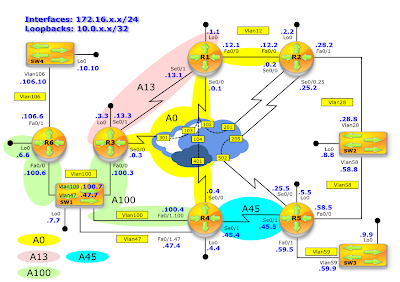Pic. 1 - Topology Diagram.
Task 1
Remove OSPF configuration applied in the previous lab.
Task 2
On R1 advertise the loopback0 address (10.0.1.1/32) into OSPF area 0 (currently it is in area 13).
Task 3
On SW2 create summary route 172.16.0.0/16 and 10.0.0.0/16 with the next hop address of 172.16.28.2 (R2).
Task 4
SW2 is connected to ISP. Configure a static default route on R2 with the next hop of 172.16.28.8 and advertise it into OSPF domain. Do not user 'redistribute static' command to accomplish that.
Task 3
On SW2 create summary route 172.16.0.0/16 and 10.0.0.0/16 with the next hop address of 172.16.28.2 (R2).
Task 4
SW2 is connected to ISP. Configure a static default route on R2 with the next hop of 172.16.28.8 and advertise it into OSPF domain. Do not user 'redistribute static' command to accomplish that.
Questions
- What is the difference between 'default-information originate' and 'default-information originate always'?
- Are there any other methods of introducing a default route into OSPF domain?
Lab Solution
Solution configuration can be accessed below (if you want to save it, click the link, then go to File-->Download):
https://drive.google.com/file/d/0BwE5C95tpjZOR1RfOG1OWk13TkU/edit?usp=sharing
Task 1
Remove OSPF configuration applied in the previous lab.
R4 Config:
!
interface Serial0/1
no ip ospf flood-reduction
!
R5 Config:
!
interface Serial0/1
no ip ospf flood-reduction
!
R4 Config:
!
interface Serial0/1
no ip ospf flood-reduction
!
R5 Config:
!
interface Serial0/1
no ip ospf flood-reduction
!
Task 2
On R1 advertise the loopback0 address (10.0.1.1/32) into OSPF area 0 (currently it is in area 13).
R1 Config:
!
router ospf 1
network 10.0.1.1 0.0.0.0 area 0
!
Task 3
On SW2 create summary routes 172.16.0.0/16 and 10.0.0.0/16 with the next hop address of 172.16.28.2 (R2).
SW2 Config:
!
ip route 172.16.0.0 255.255.0.0 172.16.28.2
ip route 10.0.0.0 255.255.0.0 172.16.28.2
!
Task 4
SW2 is connected to ISP. Configure a static default route on R2 with the next hop of 172.16.28.8 and advertise it into OSPF domain. Do not use 'redistribute static' command to accomplish that.
R2 Config:
!
ip route 0.0.0.0 0.0.0.0 172.16.28.8
!
router ospf 1
default-information originate
!
R1 Config:
!
router ospf 1
network 10.0.1.1 0.0.0.0 area 0
!
Pic. 2 - 10.0.1.1 in OSPF Area 0.
On SW2 create summary routes 172.16.0.0/16 and 10.0.0.0/16 with the next hop address of 172.16.28.2 (R2).
SW2 Config:
!
ip route 172.16.0.0 255.255.0.0 172.16.28.2
ip route 10.0.0.0 255.255.0.0 172.16.28.2
!
Task 4
SW2 is connected to ISP. Configure a static default route on R2 with the next hop of 172.16.28.8 and advertise it into OSPF domain. Do not use 'redistribute static' command to accomplish that.
R2 Config:
!
ip route 0.0.0.0 0.0.0.0 172.16.28.8
!
router ospf 1
default-information originate
!
Pic. 3 - Routing Table on R1.
At this point, SW2 should be able to reach all OSPF enabled subnets and loopbacks.
Study Drill
OSPF router can introduce default route into the routing domain using a bunch of methods. Static default route can be redistributed into OSPF or advertised into OSPF with 'default-information originate [always]'. The keyword 'always' is only necessary when OSPF router injecting default route does not have it in its routing table. If it is present (static default route), the keyword 'always' is not needed.
There are also two other ways of introducing default route into OSPF:
- Conditional default route injection
- Reliable default route injection
More on these, in later labs.



0 comments:
Post a Comment